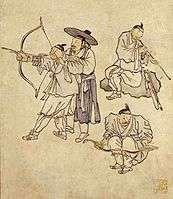Wangjin
| Wangjin | |||||||
|
Wangjin | |||||||
| Chinese name | |||||||
|---|---|---|---|---|---|---|---|
| Traditional Chinese | 網巾 | ||||||
| Simplified Chinese | 网巾 | ||||||
| |||||||
| Korean name | |||||||
| Hangul | 망건 | ||||||
| Hanja | 網巾 | ||||||
| |||||||
Wangjin is a kind of traditional headband worn by adult men in Chinese Ming Dynasty, Korean Joseon period, Vietnam Later Lê dynasty to Nguyễn dynasty and Ryukyu Kingdom to hold their hair in place after the topknot is done. It is usually made by weaving dyed horsehair.
History
According to the legend, the earliest people who wore Wangjin were the Daoshi. One day, The Hongwu Emperor of Ming Dynasty wore common clothes to visit the folk and he saw a Daoshi wore Wangjin on top of his head. The Emperor asked the Daoshi what is it and then the Daoshi answered "This is Wangjin, wear it on top of your head, then your hair will gather together" (「此曰網巾。裹以頭,則萬髮俱齊。」). The Emperor was really satisfied with this answer that contained meaning of united the country. After the Emperor returned to his palace, he ordered that all the men in the country including the emperor to the ordinary people must wear Wangjin on their head. Since then, Wangjin became common headgear of adult men in the entire country. After collapse of the Ming Dynasty, the Manchu people established the Qing Dynasty, due to the Manchu government policy that banned Chinese people to wear Hanfu and forced people to shave their hair and wearing queue, the use of Wangjin in China came to an end.
Influence
Similar to Hanfu, Wangjin also spread to neighboring countries that had tributary relationships with the Ming Dynasty, such as Joseon. It is known as manggeon in Korean.
|

